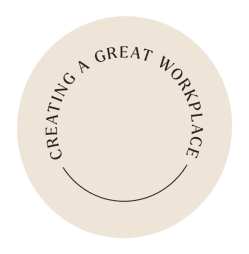I recently had the privilege of speaking to the team of UCF Fellow, Laurel Flaningan, at Amazon. My conversation with them sparked a desire to let YOU learn from Laurel’s wisdom. As the Worldwide Operations Internal Communications Manager, Laurel is on the frontlines of the intersection of communications and culture. Read on to hear how one of the largest organizations in the world is helping every associate know that what they do matters.
Q: As a leader for internal communications at a global organization, what unique role do you see your team playing in culture-building efforts?
A: I see two areas where we specifically influence culture. I would start with how our communications team is organized. We have single-threaded leaders assigned to each business line. Those leaders are meeting with ops leaders regularly to build trust and really understand what’s going on within operations that we can help with. Their role is understanding what the North Star is for the business.
- What’s the rallying cry that our ops leaders want to rally associates and managers around?
- What are the business objectives and new innovations that might be happening?
- And then how can we align our communications strategies to help really bring our employees closer to that strategy?
Amazon is huge, but we want every associate and manager to know that everything that they do matters. And ultimately, it’s what enables the company to deliver smiles to customers every day. That org structure helps our team build our business acumen, understand what’s going on (including the culture and the pulse of how our employees are feeling), and then determine how we can partner with ops leaders to develop communication strategies that really help them. Maybe it’s changing hearts and minds, or celebrating things that our employees are doing, or helping them understand why change or innovation is happening and the important role that they play in making that happen. The 360-degree visibility we have within the operation and the relationships we have nurtured allow us to jump in and help influence and grow the culture.
The second area through which we influence culture is storytelling. We have so many Amazonians working across worldwide operations. Finding ways to uncover those stories, tell them through the voices of our associates and managers, and then ultimately amplify those stories is so important. When we put those stories out there, it spurs Amazonians to connect and have conversations around them. While we might have an associate working in a building in Seattle and somebody working in Japan, they can connect through the shared North Star that we’re focused on – delivering smiles for customers. Through stories, we see how Amazonians are working as a team and going above and beyond for things like making sure that a package arrives on time, whether it’s for a special occasion, or maybe it’s even an essential item during the COVID-19 pandemic.
Q: What Amazon stories are you drawn to tell that exemplify the brand story?
A: One of our leadership principles, and really what the company was built on, is customer obsession. So all day, every day, we obsess over customers, and we’re always asking ourselves, “What do they want? What would delight them? And how can we work back to deliver what they need?” That is a feeling that’s within just about every Amazonian, and so that’s how we operate. Uncovering the stories that exemplify that principle, showing how quickly associates or managers will work together, even across business lines from a fulfillment center to a delivery station, is so powerful.

One story that comes to mind, which is one of hundreds that we could tell, is about a woman who was marrying the love of her life; she had been with her for almost a quarter of a century. And then she learned that her wedding dress was not going to arrive in time for the ceremony. Can you imagine, you’ve waited so long to be able to marry the love of your life, and then you find out that your dress isn’t going to get there? And so as soon as our site learned about this, the employees set in motion an extraordinary team effort. They coordinated across all of our supply chains to make this happen. In the end, we had about 25 different associates and managers working across state lines to make sure that this dress got on the trailer from South Carolina to Florida. They stopped at nothing to make sure that the customer had her dress on her special day.
And these things happen around the clock. Something that we’re truly going to invest in more in the future is storytelling and making it our top priority to uncover these stories that truly exemplify our leadership principles and illustrate how we obsess over customers and how our associates work together to make magic like this happen.
When our employees hear a story like that, it unleashes pride. Telling stories like that brings to life that leadership principle and North Star of customers obsession. But it’s also a recognition tool. So, when we tell these stories and we show how our associates and managers go above and beyond to make these things happen, it’s also an opportunity to celebrate those involved. It’s just a wonderful example of how if we obsess over customers like this, everybody wins. The customer wins, and the employees who are recognized win.
Q: Human Resources and Internal Communications have some interesting intersections. How can members of either team maximize their relationship?
A: Human Resources and Internal Communications should always be looking for opportunities to join forces to advocate for the employee experience. We see Human Resources as our allies and vice versa in that endeavor. Everything that we do, we want it to land in two places for employees.
- We want it to make employees say, “Wow, this is another reason why I’m so proud to work at Amazon.”
- Or maybe it’s a change, and it’s something that’s not going to make everyone happy. But we’d want the employee to say, “It sounds like you thought through everything that would affect me not just at work, but my personal life too, and I really appreciate the support and resources that you’re giving me to make this change as positive and seamless as possible.”
We agree on those two reactions. So, joining forces together to influence and to always advocate to improve the employee experience is so important.

I also think we have an advantage with how Amazon is organized, at least within fulfillment, in that we have Human Resource representatives who are actually on-site. So, they’ve got a great pulse on what our employees are feeling. What are the challenges and opportunities? That allows our team to re-prioritize our focus and our communication strategies to help with that. Since they’re on-site, they’re also the ones who often see those great stories happening. They get to serve like in-the-field reporters for us, passing those stories along. We amplify those stories, and then they get to be that in-person presence who gets to recognize and celebrate the employee on-site. They have been a great source for us in uncovering those, and it really helps their recognition and strategy for employees at the site. And in turn, it helps us further the culture by sourcing stories well and then telling them in a compelling way.
Q: We’ve talked about how you’re in the process of developing an employee value proposition. What do you think is important to future employees that maybe wasn’t a priority 5-10 years ago?
A: Previously, employers were all about finding the new shiny benefit to offer. But two things come to mind that don’t even really have a cost with them. Those two things are flexibility for work/life harmony and then opportunity and learning. We’ve learned that there are many, many different reasons why people come to work at Amazon. And there are so many opportunities within the organization to find a role that complements what you’re looking for in terms of work/life harmony and mobility, whether that’s upward mobility or moving around laterally.
I love what Jeff (Bezos) says about work/life harmony, because I feel like what we more often hear about is work/life balance. The reason we say harmony is because when you say balance, it sounds like you have to sacrifice something either in your life or work. Because work and life intersect, we talk about it as harmony. And how can that work together in the best way that is unique to the person? In terms of our Employee Value Proposition, we talk about all of the different flexible options that you can have. We have full-time roles, part-time roles, we even have roles where you can a la carte pick the schedule that you want to work. For some of our business lines, you just have to pick up one schedule a month and we offer benefits, day one. I think the flexibility and the work/life harmony is really important, so we’re definitely going to lean into that in our new EVP.
And then opportunity. Reinventing yourself is something that happens frequently at Amazon. You may have heard of our doc writing culture – the six pager. Jeff really feels that you should be able to make your case within six pages. He wants everybody to be a good storyteller and to be able to write a narrative to make a point and innovate.
So as a quick example of reinventing yourself, I’ll share about somebody within our communications department. When natural disasters happen, Amazon’s always jumping to figure out how we can make a difference.
- Can we deliver product?
- Can we support a nonprofit, make a donation?
- What will be meaningful and relevant?
- What can we do?

Previously, we didn’t have a fully developed team dedicated to this 24/7. One of the women within our department is super passionate about helping the community, so she helped coordinate some of the efforts for our department when the tsunami hit Indonesia in 2004. And through the process, she realized that we don’t have a structure where there is a team more strategically and proactively focused on helping. So, she wrote a six-page doc about what a disaster response and preparedness team could look like. And when she socialized that doc, it was like, “We absolutely need to have this!” It got approved, and she built a team of over 30 people. And now we’re doing so much more than we were when disaster hits.
That’s another thing that is really unique to Amazon: the opportunity to reinvent yourself and even moving into another role that you created yourself.
Again, the two things I just mentioned don’t really cost anything. It’s more about leaning into what people want out of life and whether it’s learning and growing, doing something new, or just having the flexibility to have that harmony with your family and loved ones at home and work. That’s what we’ve heard from our employees in terms of what they want, and we plan to continue leaning in.
Q: Where is your focus as we begin to round the corner toward 2021 and ask ourselves how we can make a positive impact in our organization and on the world?
A: Our focus is going to be on doubling down on storytelling that’s really relatable and connects to Amazonians across business lines and countries. We’re growing, growing, growing – in fulfillment alone, we have over half a million employees, and the footprint is across a number of countries. So, you just have to think as we continue to grow, how can we connect team members? We’ve seen a lot of success with stories and sharing those ways that we’re obsessing over customers or just helping each other out personally and working together as a team.
Prioritizing more storytelling is not just coming from the communications team. Something that we’re investing in next year is a roving reporter program which will identify Amazonians across operations who want to be the storyteller themselves and share the really unique things that make Amazonians peculiar and how we deliver smiles and work together in our sites. Through that program, we’ll be helping them be the voice and helping them tell the story versus that coming from the internal communications team. Right now, we’re working to identify those passionate Amazonians that also love storytelling and can be an extension of our team on the front lines.
About Laurel Flaningan

Laurel currently oversees internal communications at Amazon for North America & LATAM Customer Fulfillment. Previously, she led the workforce transformation strategy at Whataburger centered around building high performing teams by leveraging leading practice research in order to enhance the employee experience, drive business growth, and strengthen market competitiveness. Laurel has more than a decade of communications experience in a variety of roles for Fortune 500 brands like Starbucks and Southwest Airlines. She has a master’s degree and B.A. in journalism both from the University of North Texas. Laurel is a Fellow of the Unstoppable Cultures Fellowship.
Together, we truly can build Unstoppable Cultures!
Sincerely,







